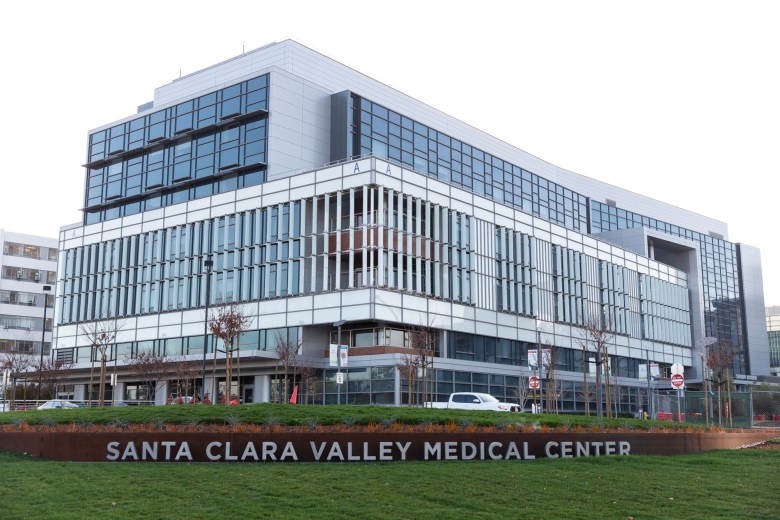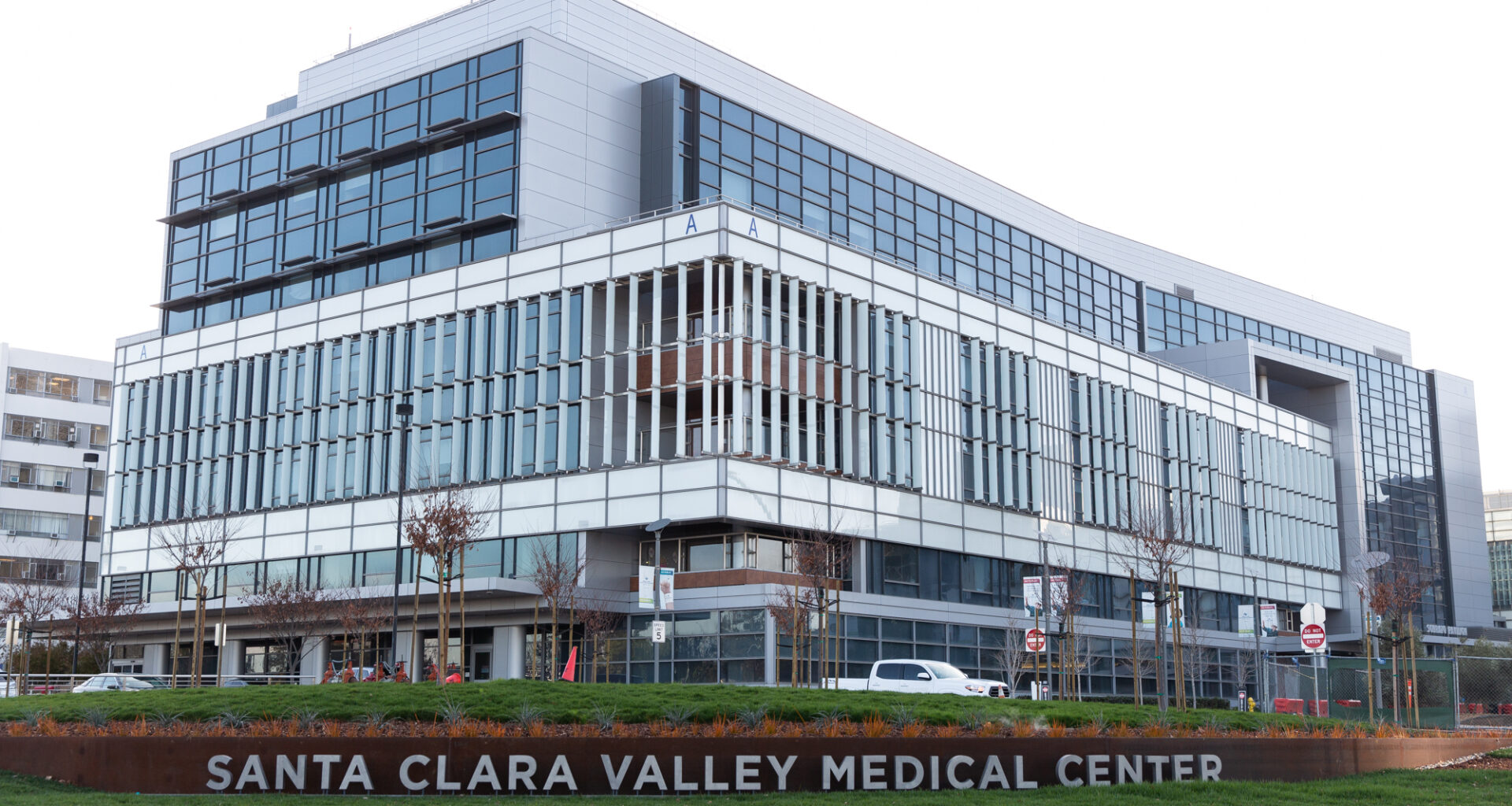 Santa Clara Valley Medical Center, shown here in 2021, would see significant funding cuts under various provisions of H.R. 1. Photo by Magali Gauthier
Santa Clara Valley Medical Center, shown here in 2021, would see significant funding cuts under various provisions of H.R. 1. Photo by Magali Gauthier
Citing the devastating impacts of recent federal legislation on the county’s health care system, the Santa Clara County Board of Supervisors agreed on Aug. 7 to place on the November ballot a sales tax measure that would bolster its fraying safety net.
The impetus for the tax measure is H.R. 1, a spending bill that was signed into law on July 4 and that includes severe cuts to Medicaid and to safety-net programs like CalFresh. County officials estimate that Medicaid cuts alone amount to about $1 trillion over the next decade. A report from County Executive James Williams and County Counsel Tony LoPresti called the reduction “the largest cuts in the nation’s history for the Medicaid and federal food assistance programs.”
“H.R. 1 represents an extraordinary threat to core safety net resources across the United States and a particularly acute threat to those services here in Santa Clara County – core services provide by this county organization,” Williams said at a special meeting that the board scheduled to discuss the tax proposal.
Under the bill’s various provisions, the county expects to see significant reductions in reimbursement for medical care at its four hospitals and 15 health clinics. Among the most significant changes is the imposition of work requirements for Medicaid recipients under 65, a rule that will take effect in early 2027 and that is expected to greatly increase the number of uninsured individuals in the county.
“This will consequently reduce reimbursements for care provided at hospitals and clinics like the County’s, while also increasing demand for emergency care sought by those who no longer access preventative heathcare after losing insurance coverage,” Williams and LoPresti wrote. “Reduced reimbursements threaten the financial viability of the County’s public health and hospital system, which provides critical life-saving services to the entire community, including emergency room, trauma, burn and cancer care, and serves all individuals in the county regardless of insurance status.
“The County’s public health and hospital system receives the majority of its funding from the federal government through Medicare and Medicaid,” the report states.
The numbers that county leaders presented to the board painted a grim picture. An analysis by Santa Clara Valley Healthcare projected that the health system will see a revenue loss of $513.1 million in fiscal year 2026-27. The deficit is projected to balloon to $1 billion in the following year and then increase to $1.2 billion and $1.4 billion over the following two years, respectively. County officials said this could mean closure of trauma centers, loss of access for many residents and overwhelmed emergency departments.
“The reality is we are already operating beyond what the current system can sustain,” said Daniel Nelson, chair of emergency medicine at Santa Clara Valley Medical Center. “The federal cuts being proposed would be devastating, pushing an already strained system into outright crisis, not just in Santa Clara Valley but across all acute care hospitals, emergency departments, behavioral health, maternal care – every part of our safety net would be impacted, leading to longer waits, worse outcomes and avoidable loss of life.”
The sales measure would ameliorate – if not entirely offset – that loss. If county voters approve the measure, the 5/8-cent sales tax would provide about $330 million in annual revenues. The tax would remain in effect for five years under the proposal that the board unanimously adopted.
Williams said that without the “backbone of revenue, the magnitude of impact for our county organization and our ability to deliver those core services is extraordinary.”
The reality is that every resident in our community will feel the consequences of these devastating federal funding cuts,
susan ellenberg, santa clara county supervisor
“This is the single largest revenue loss for the county organization, and therefore the services that we are able to provide to the community, since the passage of Proposition 13,” Williams said, citing the 1978 proposition that capped property taxes.
County supervisors strongly supported the measure, which President Otto Lee argued is necessary to offset the cuts in federal funding. The recent legislation will hurt not just the health care system, he said, but also the county’s homeless services and supportive services in Office of the Sheriff and the Public Defender’s Office.
“We’ve already cut the fat and we’ll be forced to cut to the bone, and down to the bone marrow if we don’t find a way to stop the bleeding,” Lee said. “To balance the county budget, we will have to talk about shutting down health care clinics or even county hospitals and we don’t want to cut that limb.”
Supervisor Margaret Abe-Koga was less enthusiastic about asking to the taxpayers for help. Abe-Koga, who represents a north county district that includes Palo Alto and Mountain View, noted that just one of the county’s 15 clinics – and none of its hospitals – is in her district. She pushed county officials to provide more information about their efforts to build up reserves that the county could tap into during future emergencies.
Abe-Koga also suggested that the residents her district may have other priorities, including sustainability and transportation. The former Mountain View mayor also serves on the board of the Santa Clara Valley Transportation Authority, which later that day was scheduled to discuss its position on Senate Bill 63, a tax measure to support Caltrain and other transit services. If approved, the transportation measure would appear on the November 2026 ballot.
“I also believe our taxpayers to have a certain limit, and we can’t just keep going back to them,” Abe-Koga said.
Supervisor Susan Ellenberg concurred that some people may not be excited about the new tax. But she argued that the proposed measure “is a direct and necessary response to the enormous threats to a vast array of county services, both direct and indirect.”
“The reality is that every resident in our community will feel the consequences of these devastating federal funding cuts,” Ellenberg said.
Most Popular
